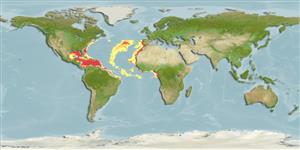Preferred temperature (Ref.
115969): 4.4 - 8.5, mean 5.2 (based on 189 cells).
Phylogenetic diversity index (Ref.
82804): PD
50 = 0.5001 [Uniqueness, from 0.5 = low to 2.0 = high].
Bayesian length-weight: a=0.00372 (0.00141 - 0.00980), b=3.11 (2.88 - 3.34), in cm Total Length, based on LWR estimates for this (Sub)family-body shape (Ref.
93245).
Trophic level (Ref.
69278): 3.2 ±0.30 se; based on food items.
Fishing Vulnerability (Ref.
59153): Low vulnerability (20 of 100).
